The tutorial explains how to do Data Validation in Excel: create a validation rule for numbers, dates or text values, make data validation lists, copy data validation to other cells, find invalid entries, fix and remove data validation.
When setting up a workbook for your users, you may often want to control information input into specific cells to make sure all data entries are accurate and consistent. Among other things, you may want to allow only particular data type such as numbers or dates in a cell, or limit numbers to a certain range and text to a given length. You may even want to provide a predefined list of acceptable entries to eliminate possible mistakes. Excel Data Validation allows you to do all these things in all versions of Microsoft Excel 365, 2021, 2019, 2016, 20013, 2010 and lower.
What is data validation in Excel?
Excel Data Validation is a feature that restricts (validates) user input to a worksheet. Technically, you create a validation rule that controls what kind of data can be entered into a certain cell.
Here are just a few examples of what Excel's data validation can do:
- Allow only numeric or text values in a cell.
- Allow only numbers within a specified range.
- Allow data entries of a specific length.
- Restrict dates and times outside a given range.
- Restrict entries to a selection from a drop-down list.
- Validate an entry based on another cell.
- Show an input message when the user selects a cell.
- Show a warning message when incorrect data has been entered.
- Find incorrect entries in validated cells.
For instance, you can set up a rule that limits data entry to 4-digit numbers between 1000 and 9999. If the user types something different, Excel will show an error alert explaining what they have done wrong:
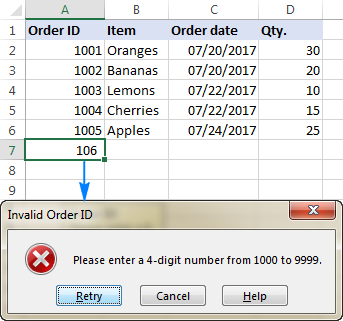
How to do data validation in Excel
To add data validation in Excel, perform the following steps.
1. Open the Data Validation dialog box
Select one or more cells to validate, go to the Data tab > Data Tools group, and click the Data Validation button.
You can also open the Data Validation dialog box by pressing Alt > D > L, with each key pressed separately.

2. Create an Excel validation rule
On the Settings tab, define the validation criteria according to your needs. In the criteria, you can supply any of the following:
- Values - type numbers in the criteria boxes like shown in the screenshot below.
- Cell references - make a rule based on a value or formula in another cell.
- Formulas - allow to express more complex conditions like in this example.
As an example, let's make a rule that restricts users to entering a whole number between 1000 and 9999:
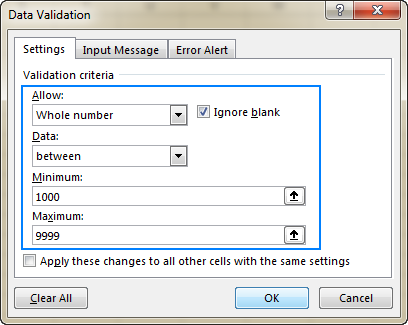
With the validation rule configured, either click OK to close the Data Validation window or switch to another tab to add an input message or/and error alert.
3. Add an input message (optional)
If you want to display a message that explains to the user what data is allowed in a given cell, open the Input Message tab and do the following:
- Make sure the Show input message when cell is selected box is checked.
- Enter the title and text of your message into the corresponding fields.
- Click OK to close the dialog window.
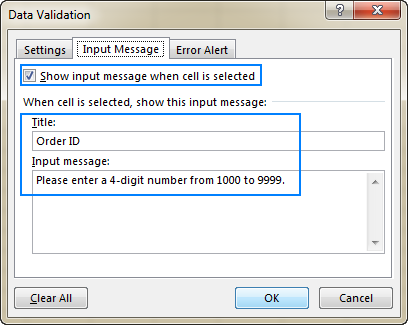
As soon as the user selects the validated cell, the following message will show up:
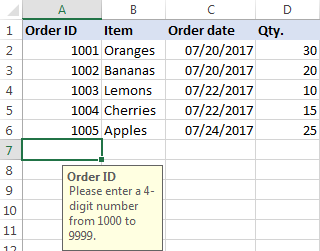
4. Display an error alert (optional)
In addition to the input message, you can show one of the following error alerts when invalid data is entered in a cell.
| Alert type | Description |
| Stop (default) | 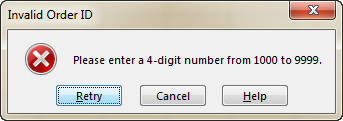 The strictest alert type that prevents users from entering invalid data. You click Retry to type a different value or Cancel to remove the entry. |
| Warning | 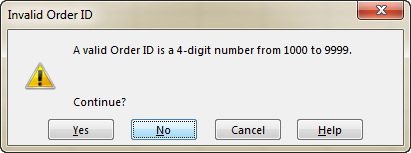 Warns users that the data is invalid, but does not prevent entering it. You click Yes to input the invalid entry, No to edit it, or Cancel to remove the entry. |
| Information | 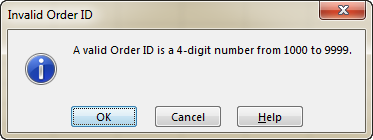 The most permissive alert type that only informs users about an invalid data entry. You click OK to enter the invalid value or Cancel to remove it from the cell. |
To configure a custom error message, go to the Error Alert tab and define the following parameters:
- Check the Show error alert after invalid data is entered box (usually selected by default).
- In the Style box, select the desired alert type.
- Enter the title and text of the error message into the corresponding boxes.
- Click OK.
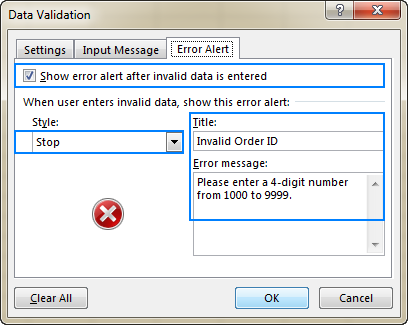
And now, if the user enters invalid data, Excel will display a special alert explaining the error (like shown in the beginning of this tutorial).
Note. If you do not type your own message, the default Stop alert with the following text will show up: This value does not match the data validation restrictions defined for this cell.
Excel data validation examples
When adding a data validation rule in Excel, you can choose one of the predefined settings or specify custom criteria based on your own validation formula. Below we will discuss each of the built-in options, and next week we will have a closer look at Excel data validation with custom formulas in a separate tutorial.
As you already know, the validation criteria are defined on the Settings tab of the Data Validation dialog box (Data tab > Data Validation).
Whole numbers and decimals
To restrict data entry to a whole number or decimal, select the corresponding item in the Allow box. And then, choose one of the following criteria in the Data box:
- Equal to or not equal to the specified number
- Greater than or less than the specified number
- Between the two numbers or not between to exclude that range of numbers
For example, this is how you create an Excel validation rule that allows any whole number greater than 0:
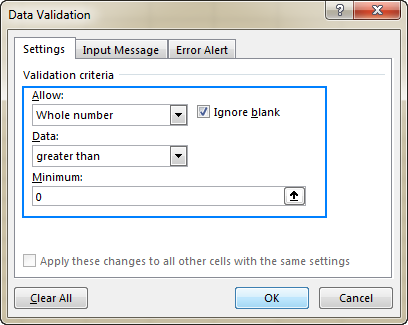
Date and time validation in Excel
To validate dates, select Date in the Allow box, and then pick an appropriate criteria in the Data box. There are quite a lot of predefined options to choose from: allow only dates between two dates, equal to, greater than or less than a specific date, and more.
Similarly, to validate times, select Time in the Allow box, and then define the required criteria.
For example, to allow only dates between Start date in B1 and End date in B2, apply this Excel date validation rule:
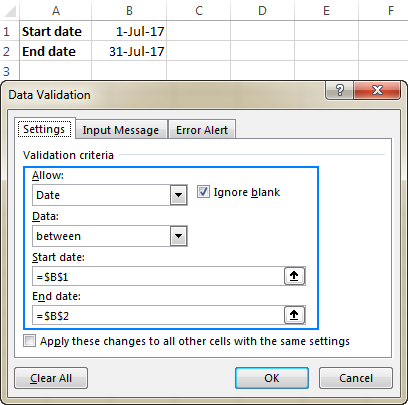
To validate entries based on today's data and current time, make your own data validation formulas as shown in these examples:
Text length
To allow data entry of a specific length, select Text length in the Allow box, and choose the validation criteria in accordance with your business logic.
For example, to limit the input to 10 characters, create this rule:
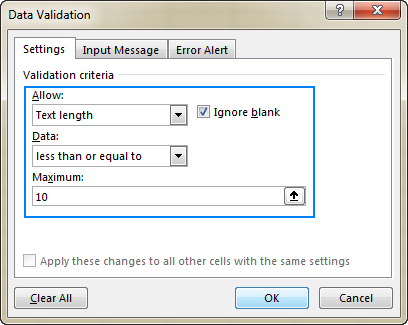
Note. The Text length option limits the number of characters but not the data type, meaning the above rule will allow both text and numbers under 10 characters or 10 digits, respectively.
Excel data validation list (drop-down)
To add a drop-down list of items to a cell or a group of cells, select the target cells and do the following:
- Open the Data Validation dialog box (Data tab > Data Validation).
- On the Settings tab, select List in the Allow box.
- In the Source box, type the items of your Excel validation list, separated by commas. For example, to limit the user input to three choices, type Yes, No, N/A.
- Make sure the In-cell dropdown box is selected in order for the drop-down arrow to appear next to the cell.
- Click OK.
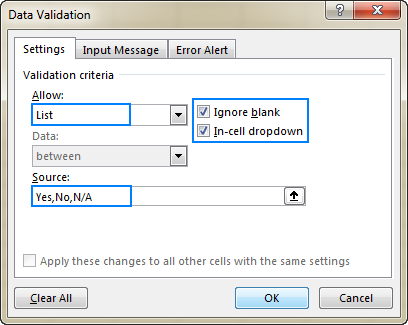
The resulting Excel data validation list will look similar to this:

Note. Please be careful with the Ignore blank option, which is selected by default. If you are creating a drop-down list based on a named range that has at least one blank cell, selecting this check box allows entering any value in the validated cell. In many situations, it is also true for validation formulas: if a cell referenced in the formula is blank, any value will be allowed in the validated cell.
Other ways to create a data validation list in Excel
Supplying comma-separated lists directly in the Source box is the fastest way that works well for small dropdowns that are unlikely to ever change. In other scenarios, you can proceed with one of the following ways:
Custom data validation rules
In addition to built-in Excel data validation rules discussed in this tutorial, you can create custom rules with your own data validation formulas. Here are just a few examples:
- Allow numbers only
- Allow text only
- Allow text beginning with specific characters
- Allow only unique entries and disallow duplicates
For more examples, please see Custom data validation rules and formulas.
How to edit data validation in Excel
To change an Excel validation rule, perform these steps:
- Select any of the validated cells.
- Open the Data Validation dialog box (Data tab > Data Validation).
- Make the required changes.
- Select the Apply these changes to all other cells with the same settings check box to copy the changes you've made to all other cells with the original validation criteria.
- Click OK to save the changes.
For instance, you can edit your Excel data validation list by adding or removing items from the Source box, and have these changes applied to all other cells containing the same drop-down list:
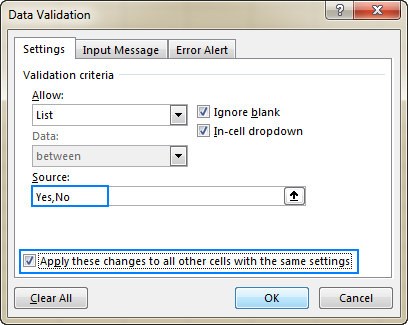
How to copy Excel data validation rule to other cells
If you've configured data validation for one cell and wish to validate other cells with the same criteria, you don't have to re-create the rule from scratch.
To copy the validation rule in Excel, perform these 4 quick steps:
- Select the cell to which the validation rule applies and press Ctrl + C to copy it.
- Select other cells you want to validate. To select non-adjacent cells, press and hold the Ctrl key while selecting the cells.
- Right-click the selection, click Paste Special, and then select the Validation option.
Alternatively, press the Paste Special > Validation shortcut: Ctrl + Alt + V, then N.
- Click OK.
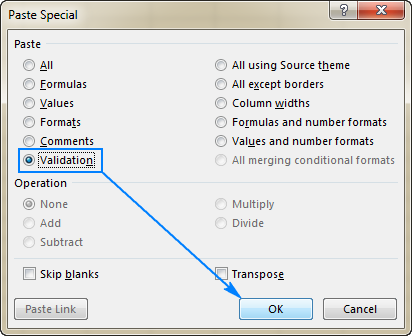
Tip. Instead of copying data validation to other cells, you can convert your dataset to an Excel table. As you add more rows to the table, Excel will apply your validation rule to new rows automatically.
How to find cells with data validation in Excel
To quickly locate all validated cells in the current worksheet, go to the Home tab > Editing group, and click Find & Select > Data Validation:
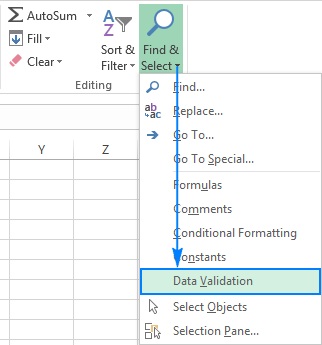
This will select all cells that have any data validation rules applied to them:

How to remove data validation in Excel
Overall, there are two ways to remove validation in Excel: the standard approach designed by Microsoft and the mouse-free technique devised by Excel geeks who would never take their hands off the keyboard unless absolutely necessary (e.g. to take a cup of coffee :)
Method 1: Regular way to remove data validation
Normally, to remove data validation in Excel worksheets, you proceed with these steps:
- Select the cell(s) with data validation.
- On the Data tab, click the Data Validation button.
- On the Settings tab, click the Clear All button, and then click OK.
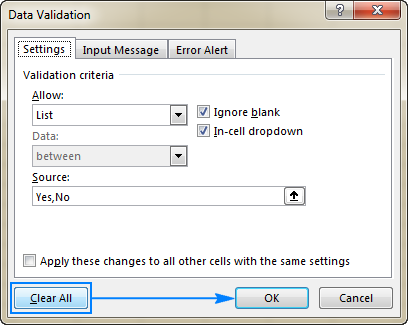
Tips:
- To remove data validation from all cells on the current sheet, use the Find & Select feature to select all of the validated cells.
- To remove a certain data validation rule, select any cell with that rule, open the Data Validation dialog window, check the Apply these changes to all other cells with the same settings box, and then click the Clear All button.
As you see, the standard method is pretty fast but does require a few mouse clicks, no big deal as far as I'm concerned. But if you prefer working with the keyboard over a mouse, you may find the following approach appealing.
Method 2: Paste Special to delete data validation rules
De jure, Excel Paste Special is designed for pasting specific elements of copied cells. De facto, it can do many more useful things. Among others, it can quickly remove data validation rules in a worksheet. Here's how:
- Select an empty cell without data validation, and press Ctrl + C to copy it.
- Select the cells(s) from which you want to remove data validation.
- Press Ctrl + Alt + V, then N, which is the shortcut for Paste Special > Data Validation.
- Press Enter. Done!
Excel data validation tips
Now that you know the basics of data validation in Excel, let me share a few tips that can make your rules a whole lot more effective.
Excel data validation based on another cell
Instead of typing values directly in the criteria boxes, you can enter them in some cells, and then refer to those cells. If you decide to change the validation conditions later, you will simply type new numbers on the sheet, without having to edit the rule.
To enter a cell reference, either type it in the box preceded by an equal sign, or click the arrow next to the box, and then select the cell using the mouse. You can also click anywhere within the box, and then select the cell on the sheet.
For example, to allow any whole number other than the number in A1, pick the not equal to criteria in the Data box and type =$A$1 in the Value box:
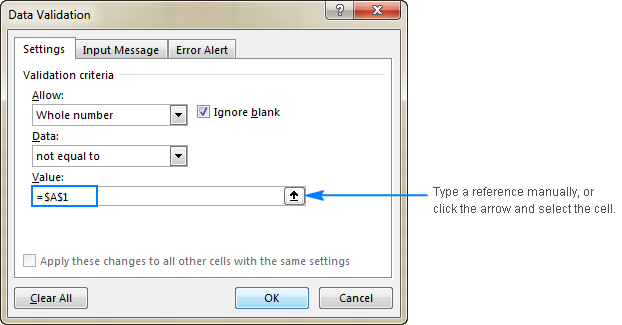
To take a step further, you can enter a formula in the referenced cell, and have Excel validate the input based on that formula.
For example, to restrict users to entering dates after today's date, enter the =TODAY() formula in some cell, say B1, and then set up a Date validation rule based on that cell:
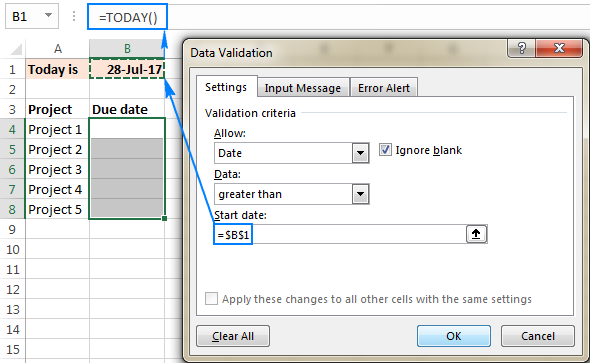
Or, you can enter the =TODAY() formula directly in the Start date box, which will have the same effect.
Formula-based validation rules
In situations when it's not possible to define a desired validation criteria based on a value or cell reference, you can express it using a formula.
For example, to limit the entry to the minimum and maximum values in the existing list of numbers, say A1:A10, use the following formulas:
=MIN($A$1:$A$10)
=MAX($A$1:$A$10)
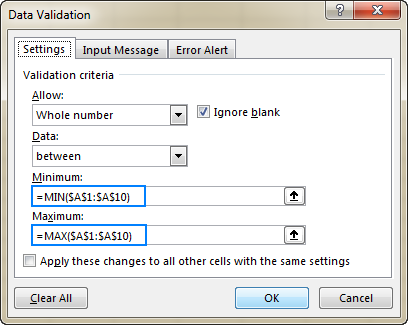
Please pay attention that we lock the range by using the $ sign (absolute cell references) so that our Excel validation rule works correctly for all selected cells.
How to find invalid data on the sheet
Although Microsoft Excel allows applying data validation to cells that already have data in them, it won't notify you if some of the existing values do not meet the validation criteria.
To find invalid data that had made its way into your worksheets before you added data validation, go to the Data tab, and click Data Validation > Circle Invalid Data.
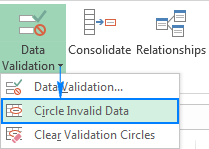
This will highlight all cells that don't meet the validation criteria:
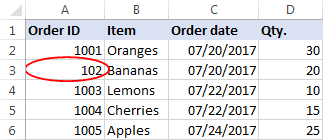
As soon as you correct an invalid entry, the circle will be gone automatically. To remove all circles, go to the Data tab, and click Data Validation > Clear Validation Circles.
How to protect a worksheet with data validation
In case you'd like to protect worksheet or workbook with password, configure the desired data validation settings first, and then protect the sheet. It is important that you unlock validated cells prior to protecting the worksheet, otherwise your users won't be able to enter any data in those cells. For the detailed guidelines, please see How to unlock certain cells on a protected sheet.
How to share a workbook with data validation
To allow multiple users to collaborate on the workbook, be sure to share the workbook after you have done data validation. After sharing the workbook your data validation rules will keep working, but you won't be able to change them, nor to add new rules.
Excel Data Validation not working
If data validation isn't working properly in your worksheets, it's most likely because of one of the following reasons.
Data validation does not work for copied data
Data validation in Excel is designed to prohibit typing invalid data directly in a cell, but it cannot stop users from copying invalid data. Though there is no way to disable copy/paste shortcuts (other than by using VBA), you can at least prevent copying data by dragging and dropping cells. To do this, go to File > Options > Advanced > Editing options, and clear the Enable fill handle and cell drag-and-drop check box.
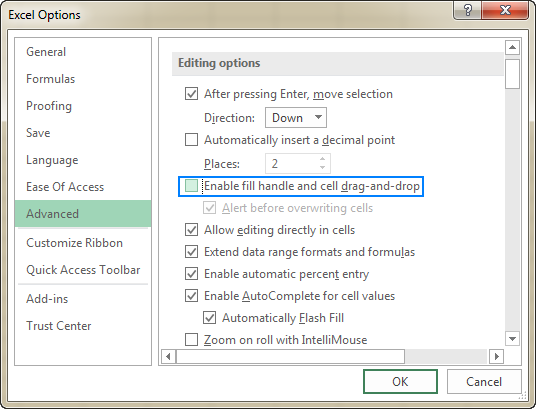
Excel data validation is unavailable when in cell edit mode
The Data Validation command is unavailable (greyed out) if you are entering or changing data in a cell. After you've finished editing the cell, press Enter or Esc to quit the edit mode, and then do data validation.
Data validation cannot be applied to a protected or shared workbook
Although the existing validation rules keep working in protected and shared workbooks, it's not possible to change data validation settings or set up new rules. To do this, unshare and/or unprotect your workbook first.
Incorrect data validation formulas
When doing formula-based data validation in Excel, there are three important things to check:
- A validation formula does not return errors.
- A formula does not reference empty cells.
- Appropriate cell references are used.
For more information, please see Custom data validation rule not working.
Manual recalculation is turned on
If the Manual Calculation mode is turned on in your Excel, uncalculated formulas can prevent data from being validated correctly. To change the Excel calculation option back to automatic, go to the Formulas tab > Calculation group, click the Calculation Options button, and then click Automatic.
For more information, please see Automatic calculation vs. Manual calculation.
That's how you add and use data validation in Excel. Another way to correctly enter data in a worksheet is to use Excel Autocorrect. I thank you for reading and hope to see you on our blog next week!
 by
by
87 comments
I needed to know how to easily copy the validation to a larger range and this page perfectly described it. THANK YOU for your clear instructions.
Help. SOS...Smoke signals please.
I am trying to set up a clockings / payroll spreadsheet and I'm having some issues. If the I column is the Normal time, I have put conditional formatting in to grey out the Over time column (J) and data validation to block entry into J. But now I have a problem as it also blocks it from entry when I is hours.
Ie. If the site supervisor enters a "s" for sick leave it must not allow entry into the overtime column, (so the I column goes yellow, the J column goes yellow and blocks entry - this is working) but if I want to allow hours to be captured into I, thus opening J for hour capture, it still blocks J. I am not sure how to get this to work. Any suggestions, please?
Hello Marlene! Data validation in Excel cannot be set or disabled based on a condition. However, you can try to do this using VBA.
Hi, can you share vba code if I have a excel sheet, where I want copy paste data or edit data but allowed only values from a list in other sheet, and prevent user to paste any value other than from list?
Hi! I think your problem can be solved with a dropdown list. The following tutorial should help: How to create drop down list in Excel: dynamic, editable, searchable. We do not do VBA code creation on request.
Is there a way i could have both options to type over a cell and have a drop down menu? this will allow me to either select from an existing pre-set range of data or type there if the value does not already exist in my drop down
Hi! You cannot manually enter a different value if you have set the data validation in a cell as a drop-down list.
Nice
excel validation as particular column should be lesser than this particular column how to do
Hi! Have you tried the methods described in this blog post? If you are not satisfied, please let me know, give an example of the desired result, and I will try to help you.
My friend has share an excel workbook, some cells are validated cell some of them are woking while some of the validated cells are not working or not showing the validated list.
See comment below.
Hey Svetlana Cheusheva,
Your article on Excel data validation was exactly right. Your clear methods and relatable examples made it simple to understand. I'm looking forward to putting these spreadsheet suggestions to work. Thank you for the fantastic information!
When I add a drop down list to my spreadsheet with 2 simple commands, yes,No and one is selected. The name in the cell disappears and the Yes or No replaces it. How can I have it just aadd the word yes or no to the cell and keep the name that is already there?
Thank you,
Rick Peterson
An Excel cell cannot have two values. You can combine the values of two cells in a third cell as described in this guide: CONCATENATE in Excel: combine text strings, cells and columns.
Getting error message that "This value doesn't match the data validation restrictions defined for this cell"...
I have tried and watch several videos, but none could solve the issue. Please help
Hi!
Check which data validation rule is set for this cell. See the article above for all the necessary information: how to find, edit and delete data validation.
I have a range of cells: A1:A6. Users can enter any numbers in these cells, but I need to restrict the sum of all numbers within this cell range to no more than 1000. I have applied data validation to the whole cell range A1:A6 with the custom formula =SUM(A1:A6)<=1000, however this does not work; only a number exceeding 1000 entered in one of the cells in the range A1:A6 triggers the prompt. If several numbers totalling over 1000, e.g. cell A1 = 500, cell A2 = 400, cell A3 = 200 are entered, the prompt does not appear.
Please could you advise how I should resolve this?
Thanks in advance.
Hello!
Use absolute cell references in your data validation formula.
=SUM($A$1:$A$9)<=1000
Works perfectly now, many thanks Alexander!
How do you analyse or collate the circled data from the data validation process? Can you put it into a table? I have around 2400 rows of data and 200 circled as invalid.
Hi!
Please clarify your specific problem or provide additional details to highlight exactly what you need. As it's currently written, it's hard to tell exactly what you're asking.
Data validation rules are preserved when copy/pasting by simply using "paste values".
A shared workbook (my friemd has share with me a workbook excel) cells are validated some are working and some others are not working. So how can i fix this problem
Hi! Regrettably, I can't provide you with any valuable recommendations without seeing your data.
Hi Chris,
Yes, they are. But regular copy/pasting also copies the contents of the source cell. To copy only the data validation rule, use Paste Special.
Hi I used the dependent drop down list validation in Excel. For example, C2 is dependent to B2. And when I change the B2, I am seeing that C2 don't refresh (to appropiate list that dependent to B2) and still remaing as previous selection. At lease C2 should refresh to blank. Any tip??
Try this in Cell C2 (if it helps)
=Indirect(B2)
Hi!
Automatic updating of values in a dependent drop-down list is only possible using a VBA macro.
This isn't exactly true. you can use formulas that leverage dynamic ranges:
=INDEX('SEARCH LIST'!$A:$A,ROW())# to find dynamically matching lookup content from a list of values in column A on sheet SEARCH LIST.
1: Data Validation List is located in a Table ("DVTable")
2: Data for the DVTable grows with the addition of new customers
Is there a way when a cell value errors as the match can't be found in the DVTable, that the user could be prompted (Info not found, Add Information Y/N) to the DV Table.
Hello!
The information you provided is not enough to understand your case and give you any advice. Explain in detail how you do Data Validation, what formulas you use.
If you're using a range of values to validate data, then this guide might be helpful: Excel dynamic named range: how to create and use.
Hi!
How to print all information if you have used data validation. I created students academic report cards and only one is displayed at a time. I want to print all of them at once.
How to allows number between 1and 60 and tow characters x and / in a sheet
Hi Svetlana Cheusheva
The article is very useful and informative. I have one question in my mind that can we apply two conditions in one cell in Data Validation as suppose we have a cell named Mobile number and I want to apply two conditions 1. The number should be 10 digits, if number is less than 10 digits then it gives alert message and if number is more than 10 digits it again gives alert message and the 2 condition will be the cell only allowed numbers not alphabets. Please explain in details. Thanks
Hello Mam to receive your blogs daily, what should I do. Please guide me.
Hi,
If I understood the problem correctly, this article will be useful to you: How to use Data Validation in Excel - custom validation rules and formulas.
Use the formula:
=AND(C2>0,C2<100)
This should solve your task.